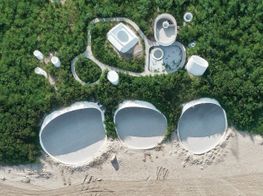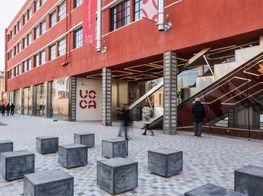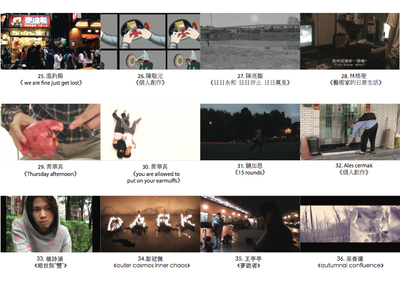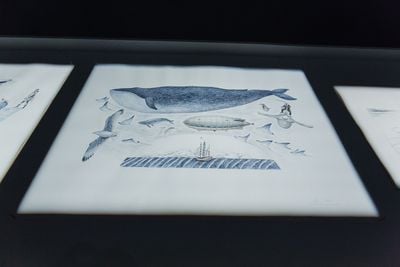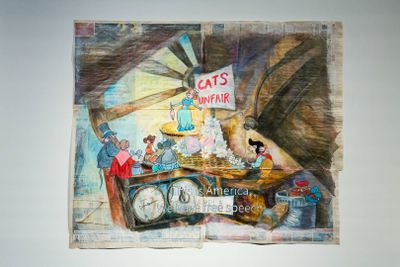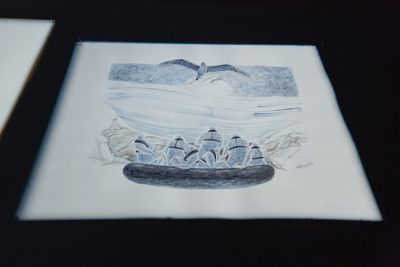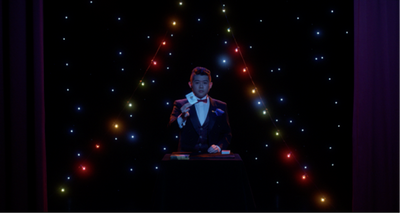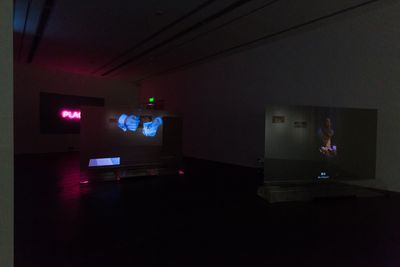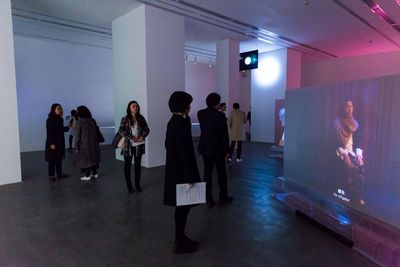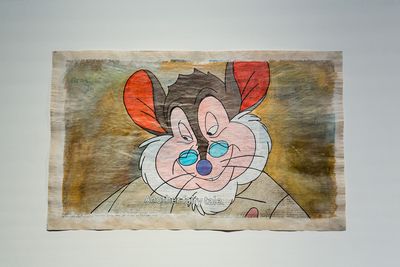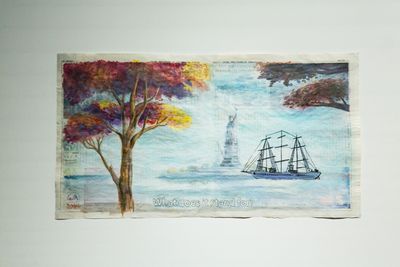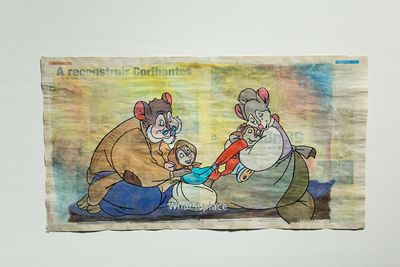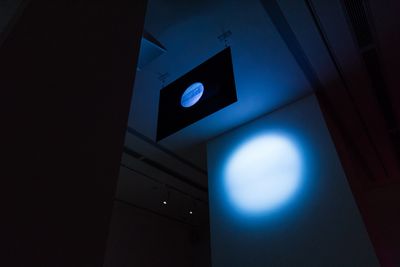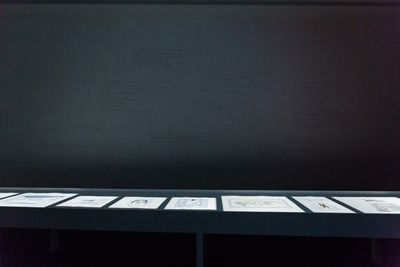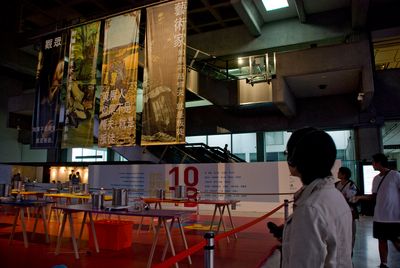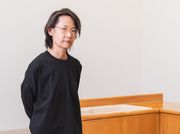Chang Yun-han
Chang Yun-han. Courtesy Ullens Center for Contemporary Art.
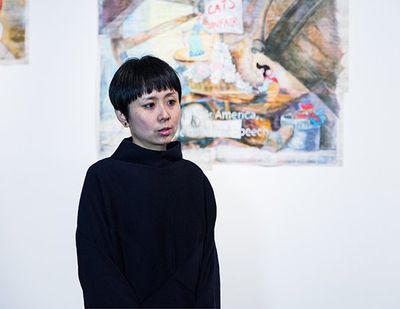
Chang Yun-han. Courtesy Ullens Center for Contemporary Art.
Based in Taipei, artist Chang Yun-han frequently carries out 'local' critiques by describing the visible and the invisible, and dealing with complex and variable narrative structures related to the contexts in which she intervenes. A graduate from the National Taiwan University of Arts with a major in sculpture, Chang extends her sculptural practice to the spatial movement of painting, sound, and video, dismantling and reconstructing events and spaces that leads audiences to unknown situations in the process.
Chang often establishes interrogative and mediated relationships in her work. Take the video installation DVD Rental—Activate Yourself! (2011), first shown at the Museum of Contemporary Art Taipei: Chang grouped together 47 pieces of video art borrowed from artist friends into a DVD rental service. During the exhibition, she encouraged the audience to actively participate in the selection and rating process, and created 'top ten' lists each week based on the audience's rental record, ranking works by different categories, such as 'what's interesting', 'what makes me bored', 'the most difficult video', thus challenging the authority and single-sidedness of an institution. This kind of reversed interrogative relationship was first shown in works like Your Museum (2008), where she playfully turned the gigantic 'Our Museum' logo on the façade of National Taiwan University of the Arts' art museum into 'Your Museum' by installing the letter 'Y'.
Chang's examinations begin with the titles of her work. The 2014 exhibition at Taipei Contemporary Art Center, You Are Not What You Think You Are, demonstrates what she achieved through her participation in The Arctic Circle residency programme organised by The Farm Foundation for Art and Science in 2014, an artist- and scientist-led expedition that brings together scientists, architects, and educators on a Barquentine sailing vessel that travels to destinations across the archipelago of Svalbard, some 10 degrees latitude from the North Pole. The result of this expedition was a series of acrylic and crayon on scroll works, You Are Not What You Think You Are (2014), which Chang created by narrating her experience orally and via texts and diaries to an illustrator, who depicted the scenery and life she encountered during The Arctic Circle expedition based on the artist's recollections. The lightly coloured drawings are independent fairytales: we see fishermen hunting whales, seabirds and hot air balloons; hunters guard a fire, while sea lions are guarding the hunters aggressively; adventurers wearing life jackets on an inflatable boat watching Sabine's gulls above their heads.
The scroll Chang produced for her Arctic Circle residency constitutes a subjective visual record of a land that is uninhabitable and desolate, offering another example of the way the artist deals with a given place in her work. This approach was exemplified in Chang's 2017 exhibition for Residency Unlimited in New York, for which she created a series of marker on newspaper drawings based on the 1986 animation film An American Tail, produced by Steven Spielberg and animated by Don Bluth, which tells the story of the Mousekewitz family, a group of Jewish mice who immigrate to America on a ship from imperial Russia. Titled Have you ever dreamed of this place? (2017), Chang's New York show consisted of used newspapers found in the city on which she drew characters from the film. The grinning Mousekewitz patriarch appears in the drawing America (2017), the title of which was written below the figure, with a heading that reads: 'Tenants: We're living in jeopardy'. The Statue of Liberty is viewed in the distance in another drawing, the title 'What does it stand for?' printed below. The glamorous city, hidden crises, the dreams of immigrants and the artist's childhood memories are all depicted in this series of direct representations that effectively stand as footnotes to the recent US election of President Donald Trump.
In March 2018, Chang opened her solo exhibition at the Ullens Center for Contemporary Art (UCCA) in Beijing (24 March–27 May 2018), for which she presented works from her Arctic Circle and New York residency programmes. The exhibition forms part of UCCA's New Directions series, which focuses on the works of emerging artists. Among the works on view is Unreachable Land (2015), a film installation that shows an iceberg as if viewed through a telescope; a neon installation entitled PLACE (2015), as well as a three-channel video installation, American Dream (2018), which consists of one video presenting a magic show that responds to Chang's narrated experiences of New York, another that records a storyteller's interpretation of that magic show, and a video that blends these two works together. In this conversation, Chang discusses her recent show, and elaborates on the works on view.
WJYour show at the Ullens Center for Contemporary Art is your first solo exhibition in Beijing. As an artist interested in the 'local experience' of the places you visit and work in, what is your impression of the city?
CYHIt is very fresh. Although we are very close in terms of ethnic identity and culture, many things are still very different here because Taiwan has been heavily influenced by American and Japanese culture. In Beijing I feel relaxed; people do not stare at me as an outsider, and do not care too much for me really, and things are relaxed in their own way. Beijing is the capital and also an ancient city of profound cultures, but has been developing at a very high rate. It feels familiar yet alien, complex and interesting. I like it a lot.
WJWhy are you showing works from both Have you ever dreamed of this place? and You Are Not What You Think You Are together for this exhibition?
CYHThe New York project includes a series of drawings of cartoon stills on newspaper, and a new series of video works, American Dream. These videos are the result of my leaving New York, when I wrote a text reflecting on my observations and experiences. I invited a magician to produce a magic show based on this text, which I then filmed. I also found a storyteller to watch the magic show and tell the story anew, offering new interpretations that I present in another video. Through these works, I mean to question the ways in which a narrative structural mode develops, and the role and position of the artist in the process.
The two projects speak a lot about my recent experiences in different countries, and about the series of works I created in different cultures and environments. The North Pole is the opposite of New York: one is a primitive, scarcely populated natural environment, the other a crowded, highly capitalist city. The two places are attractive in their own ways and my question was: how do these attractions effectively bring you away from your own place, and how do you deal with the yearning both for the place you find yourself in, and where you came from? The works seem to be speaking in their own contexts, but I think both pertain to the differences between the ideas of a place. I also wanted to ask: what kind of space can the artwork in turn create? If I were to name the exhibition myself, there would probably be keywords like 'imagination' or 'place' in its title.
WJIn your UCCA exhibition, both the magician and the storyteller videos in American Dream are performative in nature. Why did you decide to present these as videos instead of performances? How did you deal with the performativity of the two?
CYHFirstly, to me, New York is a place that has the quality of a video or a moving image. Take Times Square, for example: we have seen that place countless times in videos on various platforms, so we have already formed an impression that is much stronger than our experience of it. When I was there, I did not realise that I had 'finally arrived'; it was almost like being compressed into a video that I had already seen. Secondly, video can positively exaggerate a performance, and the audience can distance themselves from videos of performances as they are mediated and, transformed by the medium, allowing viewers to reserve their opinion regarding the validity of the performance itself. That is when imagination comes into play.
Shooting the videos, I tried to present the performativity onsite, by constructing an appropriate angle. The video of the magician presumes that the audience is right in front of the magic trick, and the video of the storyteller presumes that the audience is looking at the storyteller from a side angle.
WJYou project the storyteller and magician videos on two standing acrylic boards in the centre of the room. Additionally, a mash-up of these two videos is suspended at the entrance, thus completing the three-channel American Dream video installation. What was the intention behind this grouping?
CYHThe video close to the entrance juxtaposes the two videos; the two figures often act in synchronicity but the speeds are different. This mainly functions as an introduction to the relationship between the two works, allowing them to meet and miss each other. But when an audience is in the centre of the exhibition space, he or she can see the main videos, which are very similar and are played on a loop. First you hear the voice of the storyteller, while the magic trick oscillates near and far in relation to the narrative in the background.
Then, in the second loop, the storyteller is muted and the magic trick works on its own. I try to establish a reading that is purely visual in nature, in which the muted video of the storyteller pertains more to the act of reading.
WJThe storyteller relates a famous urban legend from New York about a sewer alligator to his own experience of the magic trick. You mentioned previously that both the magician and the storyteller were informed by the texts you provided. What exactly is the relationship between the urban legend, the magic trick and your text?
CYHI started working with the magician first, discussing how to make the text I wrote into a performance. We dealt with how to translate the atmospheres and scenes described in the text into tricks and effects. Then I sent the text to the storyteller. After discussions, he proposed to wait and feel the atmosphere on the day of the film's shooting and then reconstruct urban legends and create new narratives. I provided the storyteller and the magician with my New York photos and diaries, and asked them to try to speculate what my feelings and imaginations might be.
WJYour work tends to appear in a state of development, or at least, as a fragmented assemblage of impressions. Take the work you made during the New York residency, which patches together the visual elements—news, texts and memories—of the city. How did you approach the process of making this collage?
CYHI think it has to do with the fact that in recent years I have mostly been working on the move. With the ever-changing external environment, the reality constantly reflects my internal state. After identifying differences, I tend to go further and question the origin of my thoughts, and question what has been shaping my gaze. In hindsight, I realise that there is plenty of room for further research into the texts behind the cartoons, images, and news. I can continue investigating from different perspectives. The new works shown at the UCCA are mostly observations and responses to my experience in New York.
WJWhat were your observations of New York? How did you incorporate these observations into your work?
CYHNew York, to me, is a place that is very much about performance. Everybody seems glamorous, trying to make it out there or earn a position. It is really a place full of opportunities and uncertainty, so I thought it was like a casino, where people gamble their time or money. Instead of living there, I thought that most people are merely surviving. But it seems that as long as you are in New York you are not doing too badly.
I did not like it very much, but I had a good time. I had a budget from the residency programme, and I also have friends there. New York was like a magic show to me: you know it is not real, but you still try to enjoy it at the time. I came up with some initial ideas for some video works, and I took the chance and realised them there.
WJThe work Have you ever dreamed of this place? involves the 1986 animation film An American Tail. The original story was about a Russian mouse family immigrating to the States, thinking that the US was a place with no cats only to find out that this was not true. It was a story that started with a lie, but still ended happily. How do you remember the cartoon, and how different is it from the real New York that you found?
CYHInstead of describing the beginning of the story as a lie, I tend to think of it as an escapist imagination of everyday life, or as an anticipation of a 'better life' out there somewhere. As a child I would watch the cartoon and sing the theme song, and my comprehension of the story is just like the mouse family's lost and found experience. When I was in New York, I was reminded of the New York experience I heard about, and wondered whatever happened to my friends when they were here, and in what ways has the New York experience become part of their lives today.
When I was little, the United States represented something far away, like Disneyland. After being reminded of the cartoon, I watched it again from my position as an adult. With the realities that I have accumulated, watching the cartoon is no longer mere entertainment, but a multi-layered deconstruction of a cultural product.
WJHow was Have you ever dreamed of this place? received when you showed it at Residency Unlimited during the period of the 2017 presidential elections in the United States? You mentioned the position of the artist in the narrative, and I'm curious what aspects of the 'American Dream' you were paying special attention to?
CYHI think that the audience reacted differently depending on the country that they came from, because not all of them have watched the cartoon before. The Americans often found it ironic, in relation to the Trump administration.
Personally, the 'American Dream' has always been an aspiration for friends and relatives who emigrated to the States. But I think my yearning for the other place reflects my present situation. It becomes a hope, an incomplete eternity, so that we can always imagine a better future. When I was in New York, witnessing the various struggles of ethnic communities in the metropolis, I wondered: is this really what they want? What does the realisation of the American Dream mean to them? I think the position of the artist comes close to that of an observer, whose questions and reflections bring about expanded comprehensions and spaces for thinking with regards to the world.
WJThe deconstruction and re-imagination of the 'local' is a thread that runs through most of your works. But instead of the 'local', perhaps you are more interested in the 'locality' of a given place. Can you talk about the ways in which 'locality' is present in your practice, whether in your oral narratives, drawings, or magic tricks?
CYHI think the experience and understanding of locality is accumulated individually, and the oral narratives and imaginations are forever 'uncertain' due to the simple fact that perception and experience differ from person to person. I tend to think more in terms of how to convey and transmit experiences in different ways, while keeping a distance. The space of this distance is exactly where different viewers can place their own perspectives. Field research is an important experience for travellers from foreign countries, and it can build on their imagination. I am still deciding on the ways in which I represent and imagine another place, and this is closely associated with personal perceptions.
WJYour Museum and When You Take it Seriously (2010) both pertain to the relationships between institutions, public spaces and individuals. The former subverts the act of naming a public architecture, questions the publicity of a public space, and appears to discuss the overall concept of institutionalisation instead of revealing a specific internal problem. In a similar fashion, When You Take it Seriously discusses everyday politics within the framework of an exhibition by subverting the common museum audio guide by producing one that explicitly critiques the works on show, in this case at the Taipei Biennial in 2010.
Your work frequently mediates the relationship between the audience and a given institution. Could you talk about the way you view institutions in general?
CYHI wanted to review the ways in which an institution identifies its own concept and conception, through various problems found in everyday situations. In other words: to reveal internal paradoxes through external problems. When You Take it Seriously was first conceived when I was working on an exhibition with fellow students in the sculpture department at my university. It entered the institutional context because of the Taipei Arts Award (2009), and was presented at the 2010 Taipei Biennial as an audio guide, so the institution was an unavoidable subject that I had to deal with.
The 2010 Taipei Biennial was controversial because of the Taipei International Flora Exposition in the park adjacent to the museum (the Flora Exposition had a huge budget and created a number of problems). The audio guide apparently always describes and provides information that is beyond our viewing experience. What about the numerous invisible aspects of an exhibition? How can we reveal these? I attempted to juxtapose and compare the two, carrying out a 'fake' audio guide in a humorous, mundane way. For me, the everyday is extremely political; politics permeates life with different masks. —[O]

